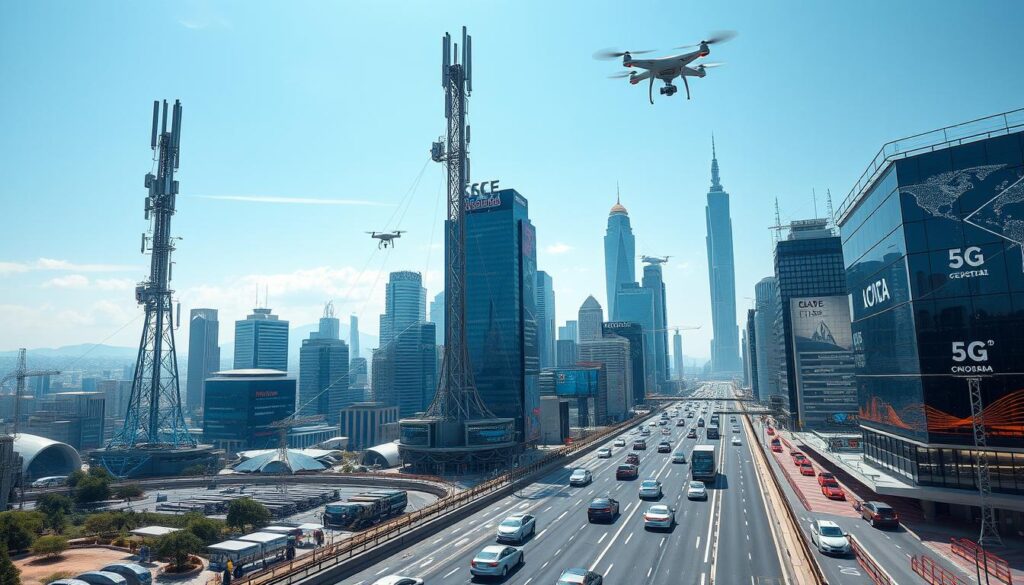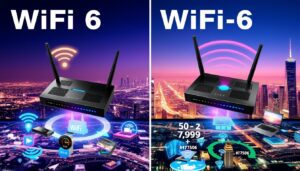What is 5G technology and how does it works. Imagine a world where thousands of devices connect instantly without lag. Streaming a movie in seconds is now possible thanks to 5G technology. This latest wireless network generation is set to change our connected future. However, how does 5G operate and what is it? Let’s examine the science underlying 5G, its development, and how it affects different businesses.
Important Notes
- Comparatively to earlier generations, 5G is the fifth-generation of wireless technology providing much faster speeds, reduced latency, and more connectivity.
- From 1G to 4G, the progress of mobile networks has opened the path for the creation of 5G, which meets the rising need for dependable and less expensive wireless communication.
- Small cell networks, massive MIMO, and network slicing—advanced technologies used in 5G—help to provide its remarkable performance and capabilities.
- With their speed and low latency, 5G might transform sectors such smart cities, healthcare, and industrial automation, so creating fresh opportunities for the Internet of Things (IoT.).
- Like any new technology, 5G begs privacy and security issues that must be resolved if its responsible and secure adoption is to be guaranteed.
Understanding the Evolution of Mobile Networks
Mobile technology has expanded greatly since the 1980s. Each each generation of mobile networks has delivered considerable gains. The preface of 5G technology is a crucial phase in this procedure.
From 1G to 4G: A Brief History
The change from 1G to 4G has seen more quickly data, better networks, and better user encounters. 1G was just for voice calls. 2G added digital data and text messages. 3G brought faster data for mobile internet and apps.
4G, or LTE, has made mobile broadband even faster. It offers quick data speeds and low latency for smooth streaming and real-time chats.
The Need for 5G Technology
As more people use mobile data, 4G networks struggle to keep up. 5G is here to solve these problems. It promises ultra-fast speeds, low latency, and more network capacity.
5G will change how we use the internet. It will power the next big steps in 5g networks and mobile network evolution.
There are notable differences between 4G and 5G
4G and 5G share some necessities, but 5G is a significant stride forward. 5G can rates of reach of up to 10 Gbps, far quicker than 4G’s 100 Mbps. Furthermore, it has significantly lower latency, making it perfect for 4g vs 5g applications such as self-driving cars and remote healthcare.
The growth of mobile networks shows our drive for better connectivity. We are entering a new digital era with 5G. It will change many industries and shape our connected future.
What is 5G Technology and How Does It Works
5G is the next big thing in wireless tech. It’s going to change how we connect and use the digital world. It uses new radio waves and antennas to give us faster speeds, lower delays, and more network power than before.
5G works with millimeter-wave (mm Wave) frequencies to send data super fast. But, these waves don’t travel far and can get blocked by things like buildings. To fix this, 5G uses lots of small cells in cities and suburbs to keep connections strong.
Massive MIMO technology is also key to 5G. It uses many antennas to handle lots of devices at once. This makes the network more efficient and reliable, even when lots of people are online.
5G also brings network slicing. This lets networks create special, custom slices for different needs. It helps ensure important services like remote healthcare get the best performance.

The world needs faster, better wireless networks more than ever. Everything will change as a result of 5G’s new capabilities and technology. It will improve our quality of life, change industries, and usher in a more interconnected future.
Core Components of 5G Infrastructure
As we look forward to 5G technology becoming more common, it’s key to know its main parts. Small cell networks and advanced MIMO technology are changing how we connect. They’re making mobile internet faster and more reliable.
Small Cell Networks
Small cell networks are a big part of 5G. These small, low-power base stations are set up in busy places. They help improve coverage and speed, making 5G even better.
Massive MIMO Technology
Another crucial component of 5G is massive MIMO technology. To broadcast and receive data simultaneously, it makes use of several antennas. This makes signals stronger and helps 5G handle more data and devices.
Network Slicing Capabilities
One significant element of 5G is network slicing. It enables the division of 5G networks into distinct virtual networks. Each one is tailored for different uses, like fast data for machines or high-quality video streaming.
A new era of connection is being ushered in by these 5G infrastructure components. They will improve our lives and transform numerous industries. They’re helping us move towards a more connected world.

Speed and Performance Benefits of 5G
We are currently in a a new phase of lightning-fast 5G speeds and outstanding network performance I appreciate the introduction of 5G technology. It provides an experience. that is revolutionary and far better than its precursors. This can change how we use the digital world.
One key benefit of 5G is its 5g latency. Here’s the speed at which data moves from a device to the network. In contrast to to 4G, 5G latency is typically only a several milliseconds. This rapid response time creates new chances, such as necessary medical care applications and playing games in real time.
But 5G’s advantages don’t end there. It also offers 5g performance that’s truly impressive. Regarding download speeds up to 10 Gbps, 5G makes data transfers, live streaming, and file downloads amazingly quick. This not only gets better our personal experiences but also opens new prospects for companies to grow and create something new.
“5G will get an another period of super low inactivity, lightning-quick rates, and exceptional execution, changing the manner in which we work, play, and live.”
The benefits of 5G networks will only grow as they grown up. and expand. It will support the expansion of the Internet of Things and smart cities. Additionally, it will transform industrial automation and healthcare, demonstrating 5G’s limitless possibilities.
Real-World Applications and Use Cases
5G technology has changed many industries, bringing new ideas to life. It’s increasing city intelligence, automating industries, and improving healthcare. The our lifestyle, work, and engage with one an additional is being changed by 5G.
Getting in touch Smart Cities and the World Wide Web
5G is making smart cities a reality. It lets cities use IoT devices to gather and share data. This helps cities manage traffic better, keep the environment clean, and connect cars to the internet.
Healthcare and Telemedicine
5G is having a significant positive impact on healthcare. 5G is used in telemedicine to monitor patients and conduct virtual doctor appointments. This makes healthcare more accessible and efficient.
Industrial Automation
5G is changing how we make things. It supports Industry 4.0 by making machines work together better. This means factories can work faster, safer, and more flexibly.
| Sector | 5G Applications | Key Benefits |
|---|---|---|
| Smart Cities | Intelligent traffic control Environmental monitoring Autonomous vehicles | Optimized infrastructure Improved public services Enhanced sustainability |
| Healthcare | Telemedicine Remote patient monitoring Real-time data sharing | Improved accessibility Enhanced patient outcomes Efficient healthcare delivery |
| Industrial Automation | Remote control of machinery Real-time data analytics Advanced automation | Increased efficiency Improved safety Greater flexibility |
5G is amazing, opening up new ways to innovate and grow. As we use 5G more, we’ll see even more exciting changes soon.
5G Security and Privacy Considerations
The world is moving fast with 5G technology, bringing new speeds and abilities. But, we must talk about the security and privacy issues it brings. The 5G network is more connected and sends more data, making it a big worry for keeping our info safe and the network secure.
Securing the 5G Network
5g security is a big deal now. Telecoms and tech companies are working hard to keep the network safe. They’re using:
- Advanced encryption to protect data
- Strong systems to check who’s on the network
- Tools to find and stop cyber threats
Addressing Privacy Concerns
The 5G network collects and shares more data, making people worried about privacy. To fix this, companies are finding new ways to keep our info private, like:
- Creating strong privacy rules
- Letting users control their data better
- Using new ways to hide sensitive info
By focusing on network protection and privacy, 5G can reach its full potential. This way, we can use this new tech safely and trust it.
“Adopting 5G technology necessitates a comprehensive security and privacy strategy to maintain user confidence and the long-term sustainability of this ground-breaking network.”
In conclusion,
Describe 5G technology and its operation. Wireless communication is undergoing a transformation thanks to 5G technology. It provides low latency and quick speeds. This technology will make our future more connected and advanced.
5G network deployment is accelerating. Leading US companies include Verizon, AT&T, and T-Mobile. New applications like smart cities and improved telemedicine will emerge as 5G expands.
The journey doesn’t stop at 5G. Scientists are working on 6G and beyond. They aim for even faster speeds and better connectivity. With 5G’s growth, we’re entering a new era of digital interaction.
FAQ
How does 5G technology operate and what is it?
5G is the newest wireless technology. It offers enhanced connection, reduced latency, and increased data rates. To efficiently transfer data, It is useful of small cell towers, advanced antennas, and waves of high frequency.
What is the variation between 5G and previous wireless technology generations?
5G is a major progress over 4G LTE. It has greater device management capabilities has 10 times lower latency, and is up to 100 times faster. These modifications open up new potential applications and services.
Which essential elements make up 5G infrastructure?
Massive MIMO, network slicing, and tiny cells are all components of 5G infrastructure. Small cells boost coverage and capacity. Massive MIMO improves signal quality. Network slicing offers customized network experiences.
What benefits does 5G offer in terms of velocity and effectiveness?
5G promises delay of less than 1 millisecond and speeds of up to 10 Gbps. Consequently, this creates it ideal for autonomous vehicles, virtual reality, and remotely performed surgery in real time.
What usage cases and applications does 5G technology possess in the actual world?
5G can change many industries. It can make smart cities better, improve healthcare, and boost industrial automation. It makes robotic surgery easier remote patient care, and devices connected to the Internet of Things.
What privacy and security problems exist with 5G networks?
5G raises security and privacy concerns. There’s a risk of more attacks and data breaches. But, network operators and device makers are working on strong security and privacy measures.






